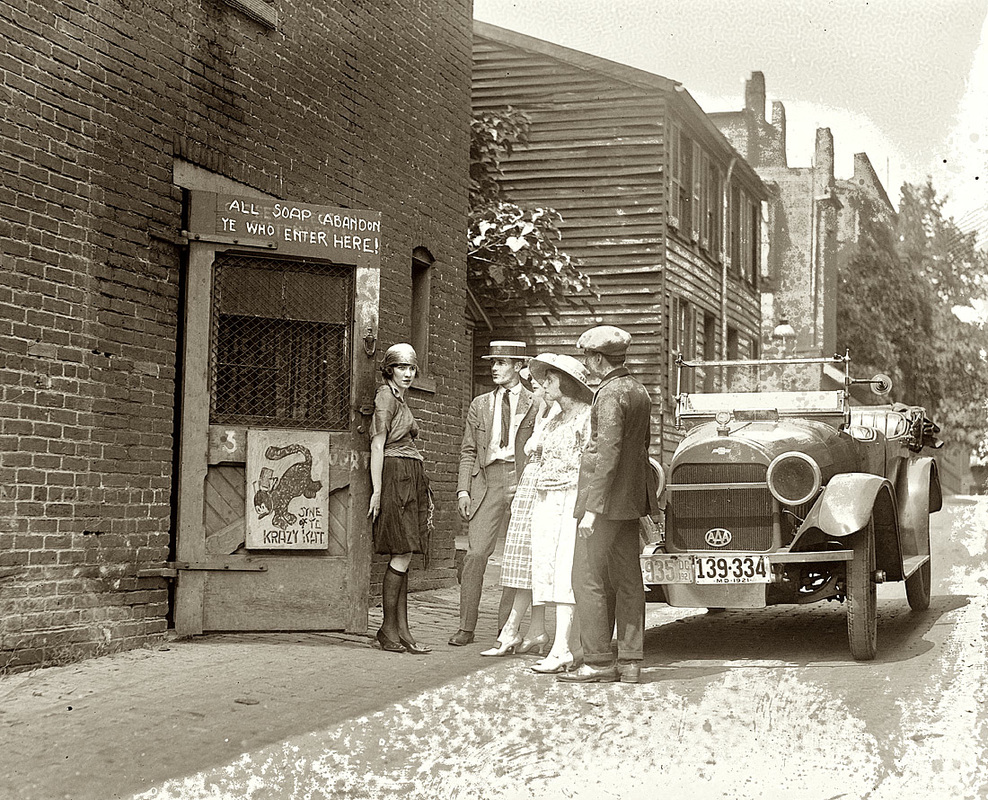The year is 1920. North America.

A Drunkard’s Progress: Moralistic Panic of Alcohol Guaranteeing the Dissolution of Families and Ruin of the Individual
Lutheran Pietist reformers sink their claws into American legislature, proclaiming a flailing, hand-wringing moral panic caused by the Satanic evils of alcohol. Christian Temperance movements force a constitutional ban on all forms of alcohol (with the exception of sacramental wine, PFFFT), making even possession for personal consumption illegal.

Enter the Speakeasy.
One of the only ways for urban residents to find alcohol was the existence of illicit, surreptitious bars known as speakeasys. Apocryphycally called such from a bartender’s term: people were meant to “speak easy” when at the bar, in order to keep from drawing any suspicion by looking around nervously or talking too loudly or quickly.
They were also known as Blind Pigs or Blind Tigers, sometimes working under the pretense of paying admission to see an animal or show while being offered a complimentary gin cocktail.
Blind Tigers worked by zero interaction with a bartender at all; patrons would walk up to a drawer, drop their coins in and shut it. It would be pushed open, money swapped for a raw glass of whiskey.
Secret coding would be employed, with booze going by such plum names as Coffin Varnish, White Mule, Horse Liniment, Monkey Rum, Panther Sweat, Rotgut and Tarantula Juice.
More Than Just a Bar
The speakeasy would transcend the label of illicit bar, particularly in New York City. NYC by far had the highest concentration of illegal drinking establishments on the continent, at peak having 32,000 bars operating in the shadows. 45th to 52nd St between 5th and 6th Ave in Manhattan had a speakeasy in every single building on the street.
These drinking establishments would often become a nexus for marginalized communities of black citizens in a time where slavery and Jim Crow laws were still an all-too-real fact of life. Harlem in particular would see an explosion of social, intellectual and artistic ideas in what would come to be known as the Harlem Renaissance.
These places would become community gathering spots where blacks and whites would congregate in a more egalitarian way than outside, giving these bars the colloquial name of “black and tan” to describe the racial divide beginning to break down. Jazz would explode, and flapper dancers would follow. This enraged Moral Reformers, with two direct quotes of particular interest from the detractors:
“The moral turpitude of Thompson Street has been notorious for years, and the mingling of the three elements does not seem to have wrought any change for the better. The border-land where the white and black races meet in common debauch, the aptly-named black-and-tan saloon, has never been debatable ground from a moral stand-point. It has always been the worst of the desperately bad. Than this commingling of the utterly depraved of both sexes, white and black, on such ground, there can be no greater abomination.”
As well as this one, made by an undercover detective:
“there are nigger wenches drinking at the bar, several coons playing dice and some white men standing around. The back room is a ‘hore house in distress (simply rotten).”
Pretty gross, right? They were terrified this would normalize racial mingling (oh my GOODNESS perish the ungodly thought) and would regularly be infiltrated by undercover police, detectives and expose journalists known as slummers, setting them up for police raids.

An unnamed Harlem speakeasy. Unsegregated and separate from the larger and white-run Mafia speakeasy establishments of the time. This would have likely been in the basement of a small brownstone building, as opposed to the elaborate ground level ones in Manhattan.
This didn’t stop these spaces from thriving despite racist Christian efforts to subjugate them. Many extremely important musicians would see their starts in these clubs, like Billie Holiday (Jerry’s Log Cabin), Louis Armstrong (Savoy Ballroom) as well as dozens of dancers showing at the hottest dance club in New York, Cat’s Corner.
Blacks and whites could intermingle and collaborate in these spaces with far more freedom than in the outside world, creating an incredibly important new social foundation that was entirely unique in North America at the time.

The Krazy Kat, one of DC’s Bohemian speakeasys.
So did Prohibition work?
Ironically, no! It literally accomplished the most detrimental possible opposite. All alcohol production was pushed from legal channels to criminal ones. Gangs exploded and ruled, with famous gangsters like Al Capone making their fortunes off the incoherent and hysterical puritan idiocy of the early 20th century. The movie Gangs of New York is based entirely around many of these precursor events, showing what a raw and violent decade the Prohibition era became.
Lecture Summary:
Survey 8: Charlestons and communists (1915 – 1925)
This period was super interesting. I loved the segment on Russian Constructivism, which came as a bit of a surprise. I’m hit or miss with much of the more abstract work of the 20th century, but that really did it for me. We also covered the escalation of WW1, women joining the workforce, touched on Dada movements, some of which I found I quite liked, which was nice! The original examples of it I’d seen just seemed obnoxiously navel-gazing, like much of contemporary conceptual art. We looked at cubism, poster design (suprematism! Woohoo!) among other influences.
Information:
Slumming and Black-and-tan Saloons: Racial Intermingling and the Challenging of Color Lines
https://www.clos19.com/en-de/speakeasy-culture
Images:
https://en.wikipedia.org/wiki/Prohibition_in_the_United_States#/media/File:The_Drunkard%27s_Progress_-_Color.jpg
https://en.wikipedia.org/wiki/Speakeasy#/media/File:Pittsburgh_Dispatch_Speakeasy_Origin.jpg

Leave a Reply